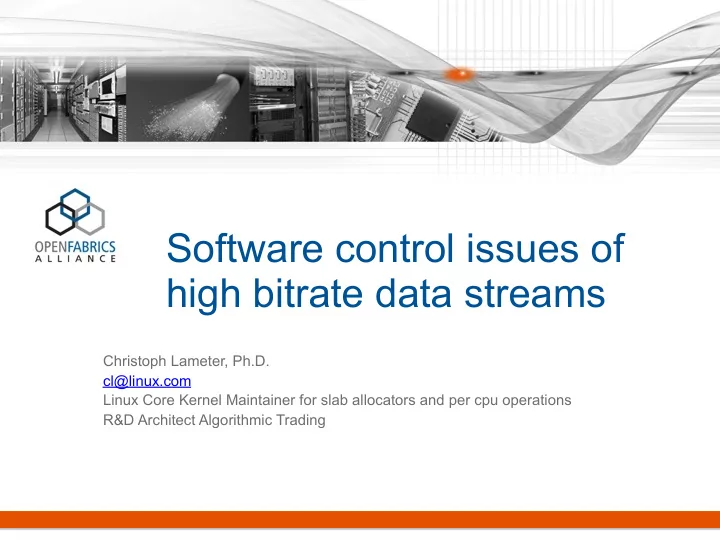

Software control issues of high bitrate data streams Christoph Lameter, Ph.D. cl@linux.com Linux Core Kernel Maintainer for slab allocators and per cpu operations R&D Architect Algorithmic Trading
Photonics for throughput and latency • HPC and AlgoTrading – Maximum Throughput – Minimal Latency – Rapid distribution of information via Multicast • Our users want “bare metal” performance – OS noise issues – Reduce size of software – SDN? Uhhh … . • What we expect from Photonics • Radically lower latency • Extremely higher throughput 2 www.openfabrics.org
POSIX / System Calls • recvmsg (), sendmsg () and TCP • Made for 10Mbps networks • Works well at 1Gbps. • Data copied to and from process address space. • Difficult at 10Gbps. Requires additional measures – Flow Steering – MultiQueue support • Mostly kept away from the application but system needs to be tuned correctly. • Single thread performance is limited. May have to distribute logic for performance reasons. • Strong jitter (10-100 milliseconds normal, seconds possible) 3 www.openfabrics.org
Open Fabric API (RDMA) • Direct Remote Memory Access ( RDMA) Designed for 10Gbps networks. • • Kernel out of the data path. Zero Copy Control via sys calls. • IBTA cross platform standardization of RDMA API • Limited by PCI-E and memory speeds • Works for 40G and 56G speeds. Additional measures • Flow control • Use cpu caches instead of memory • NIC connected to multiple sockets or NUMA nodes. • Not sure how well this works at 100G and beyond 4
FPGA • Works very well at 10Gbps • Jitter free • Current State of the Art in Electronic Trading • Complex and difficult “coding” and debugging. • Works also well at 40G and 56G. • 100G problematic with todays FPGAs but newer technology that became available in 2015 will address that. • Ability to process at line rate. Memory out of the critical path. Processes data while packet is being received. • Striving to simplify what has to be done at the FPGA level. 5 www.openfabrics.org
Real Hardware • Resource intensive to develop • Line rate • No jitter • Deterministic • Electronic Trading typically takes advantage of hardware developed for other industries because of limitations on the number of chips needed. 6 www.openfabrics.org
Controlling a high speed data stream 100G -> 1Tbps? - Requires a layered approach - All the presented techniques have their own means of control - These are already found in most high end devices today - Also present in latest paper by Harm Dorren on Optical switch (2014). - The higher the speed of the data stream the more difficult the API is that is required to be used. - POSIX and RDMA (OpenFabrics Stack) are the only standardized protocols. - Control of methods are hardware/implementation specific. - There is a project to standardize interaction with FPGA from the Linux Kernel developers. 7 www.openfabrics.org
OEO Layer 1 switches - 4ns for passing through a packet. Latency of 1 meter of fiber. - Packet is not modified - Signal conversion to electronic, amplification, and replication - Amplification and moderation of signal is controlled by FPGA - FPGA is controlled by host processor - Hots processor allows the use of RDMA APIs or POSIX APIs - FPGA programming can be controlled from Host processor - FPGA can shape the signal processing and distribution to multiple endpoints - Multiple Vendors ExaBlaze, MetaMako etc. 8 www.openfabrics.org
Recommend
More recommend